Charles E W Bean, Diaries, AWM38 3DRL 606/249/1 - 1917 - 1932 - Part 5
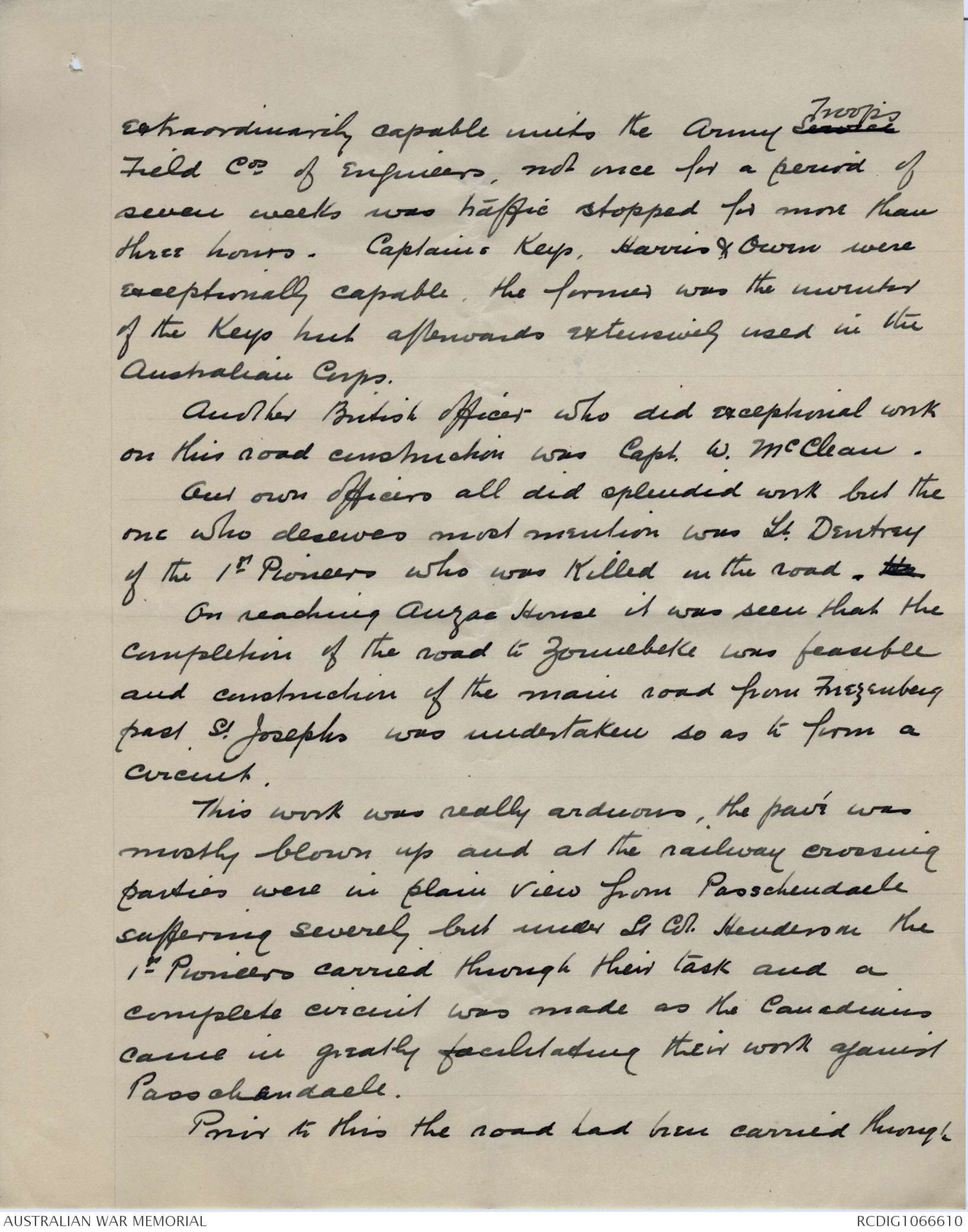
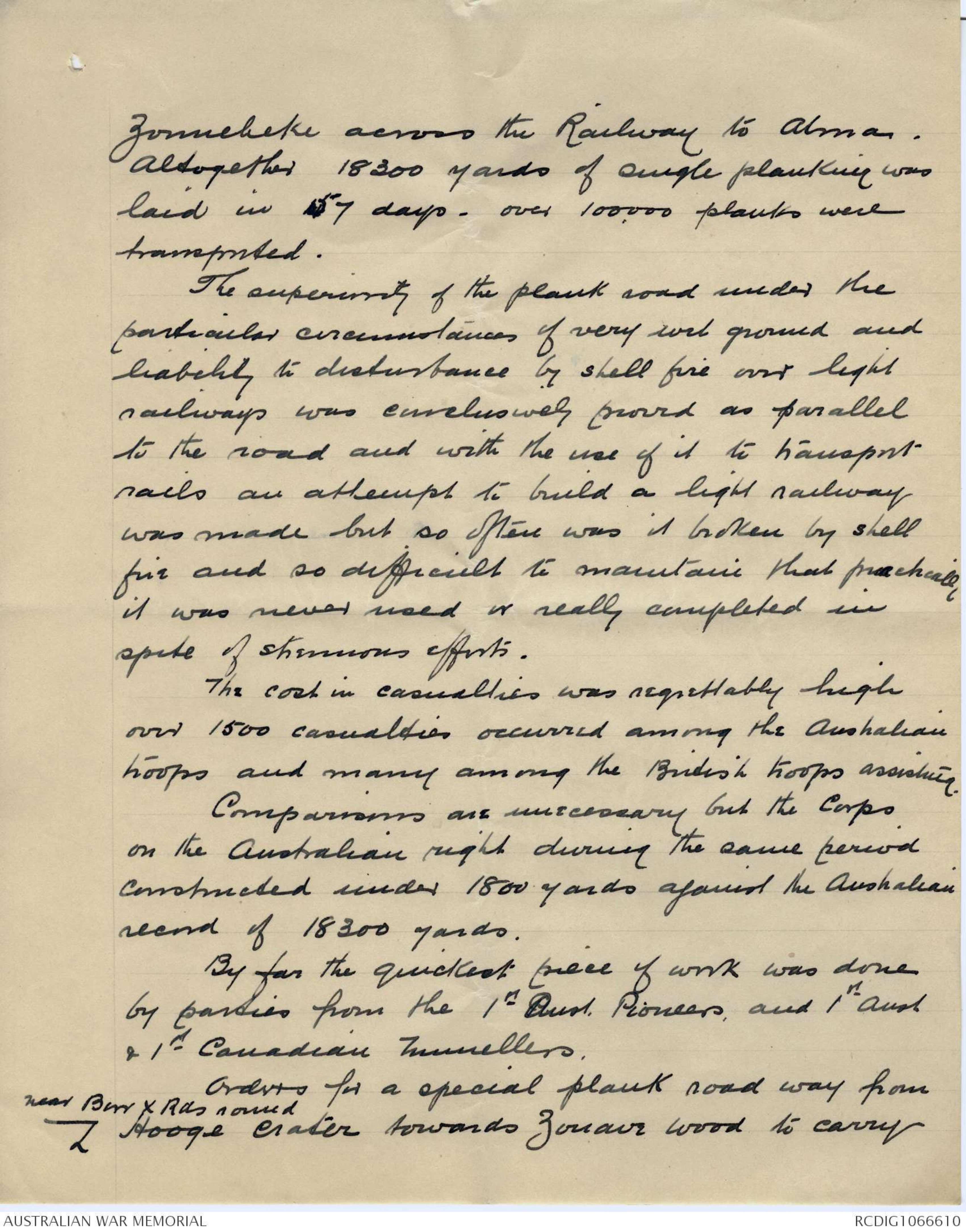
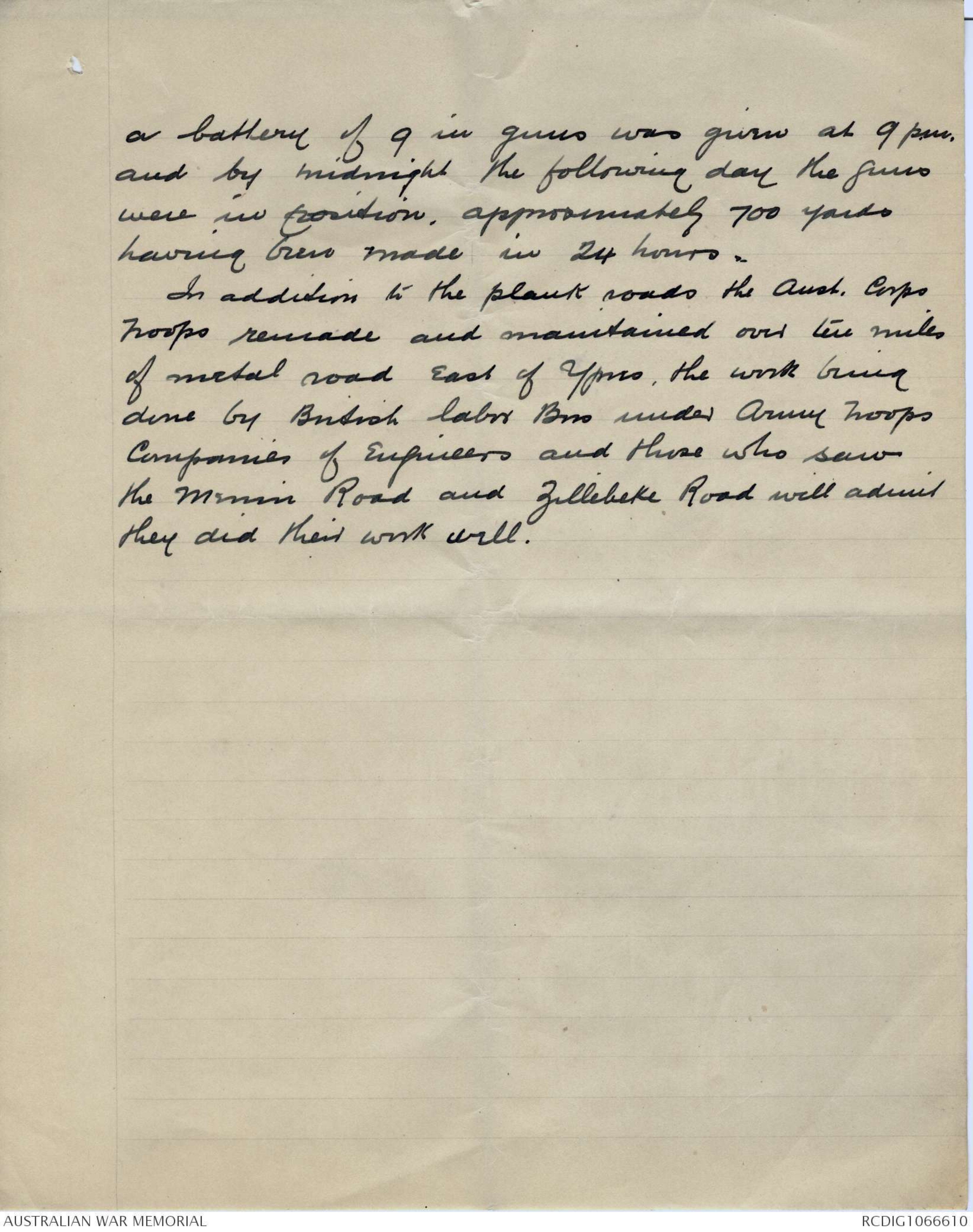
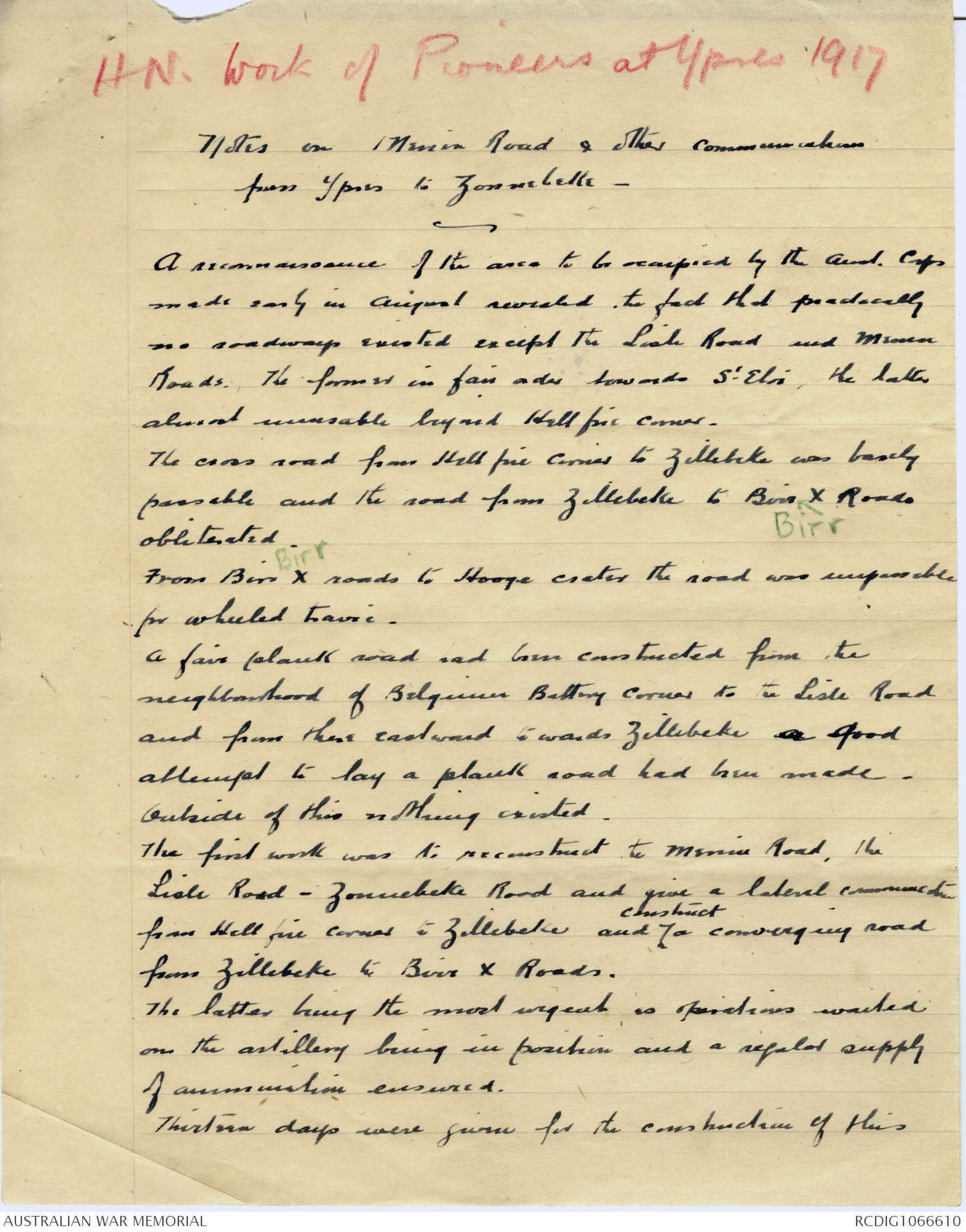
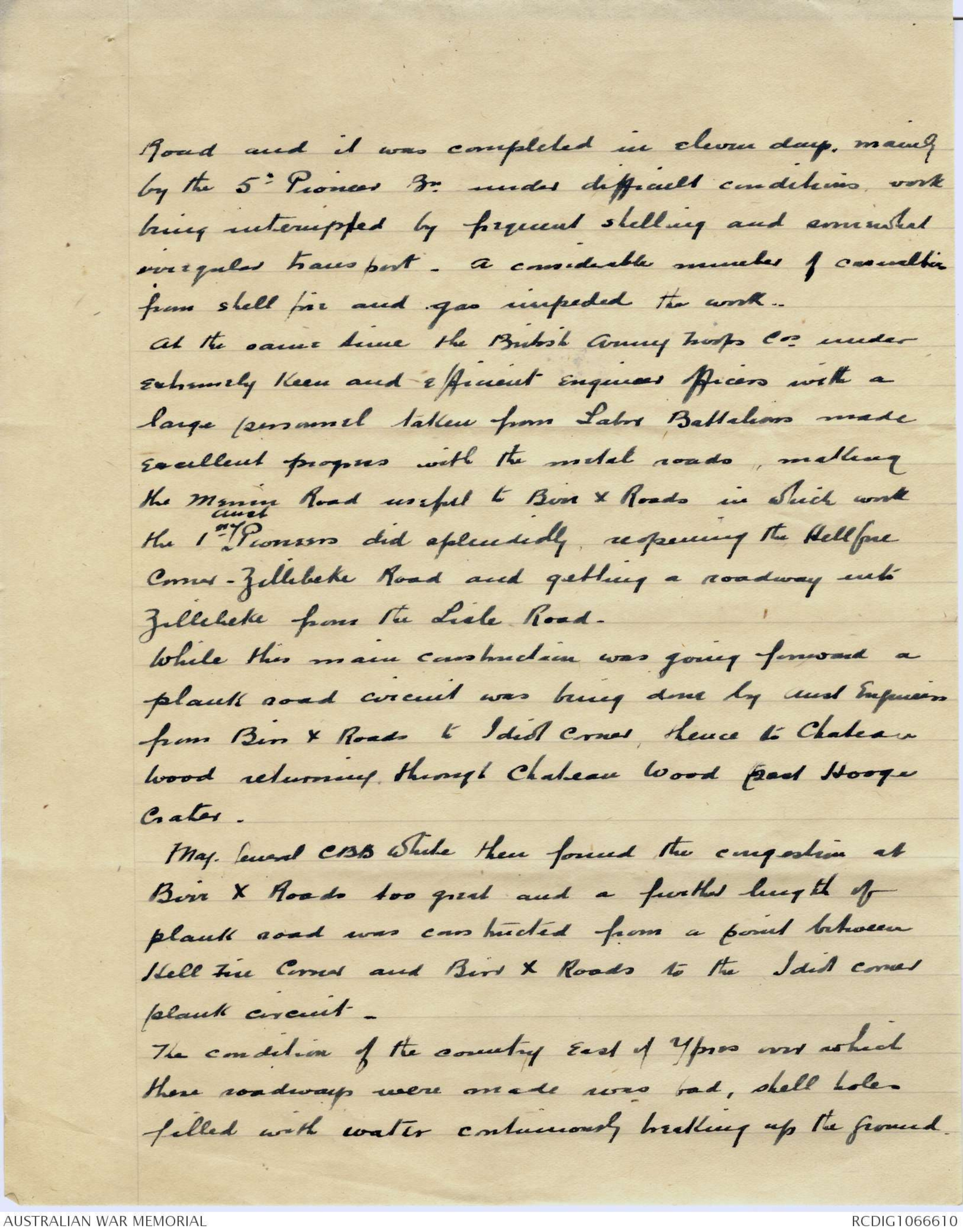
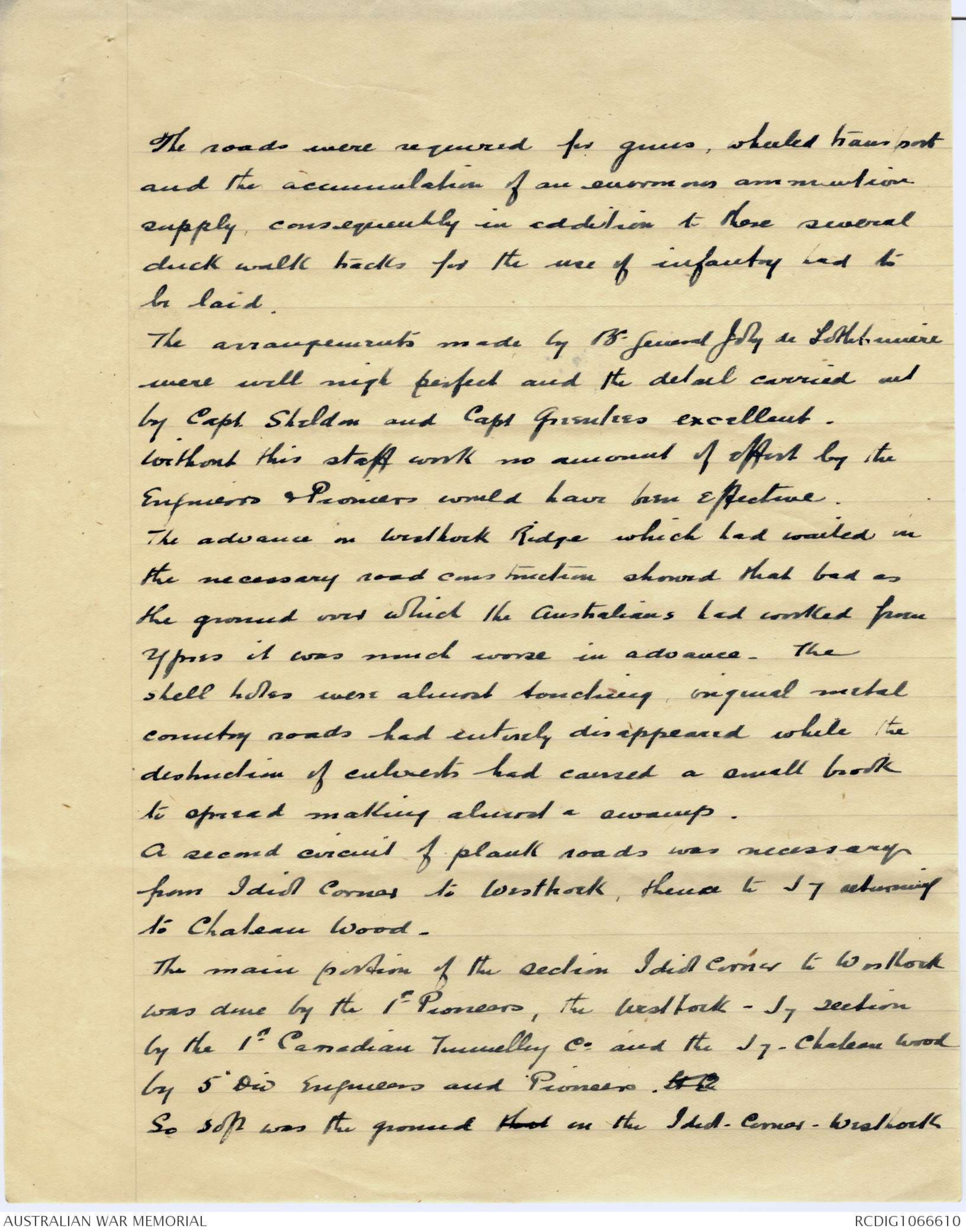
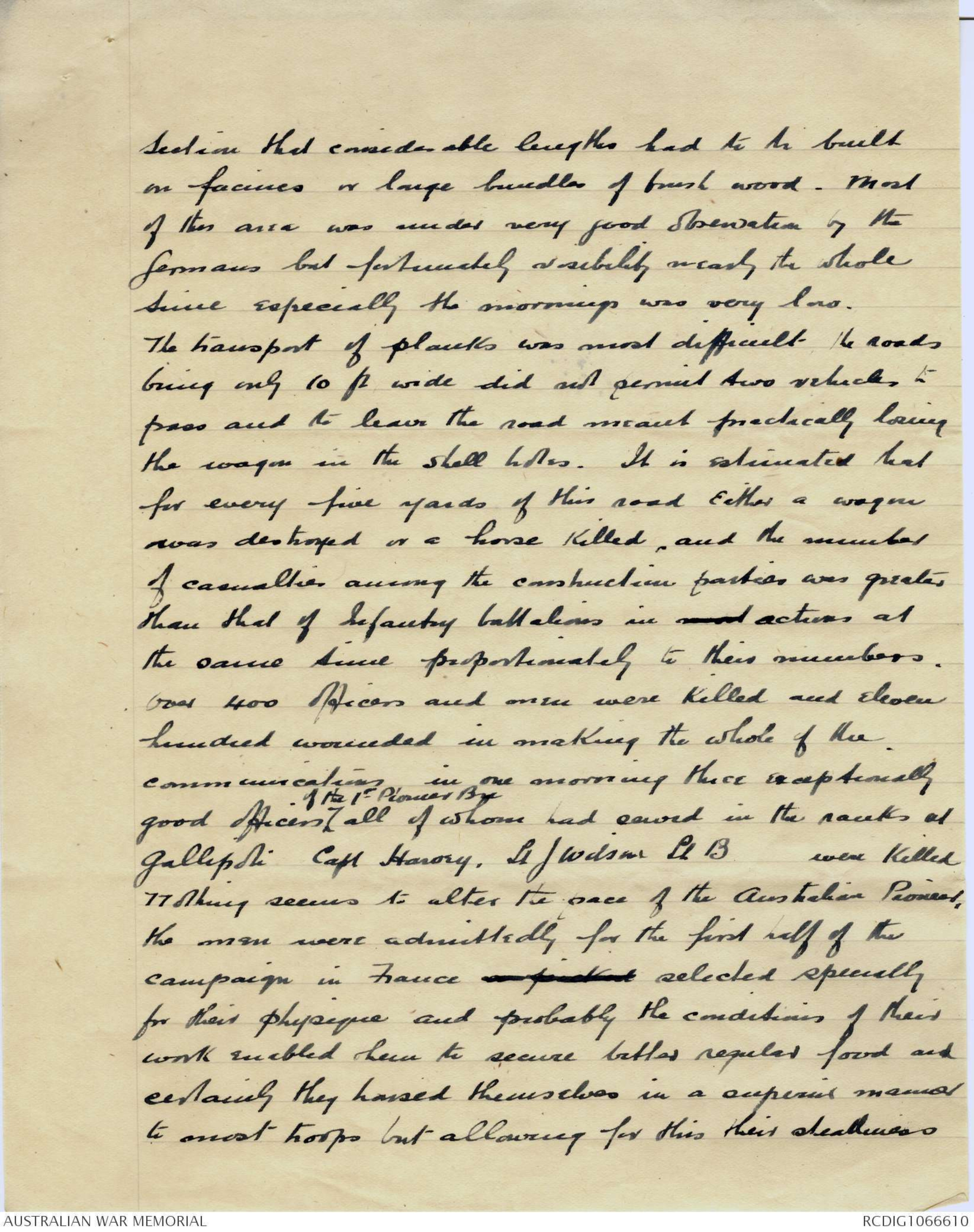
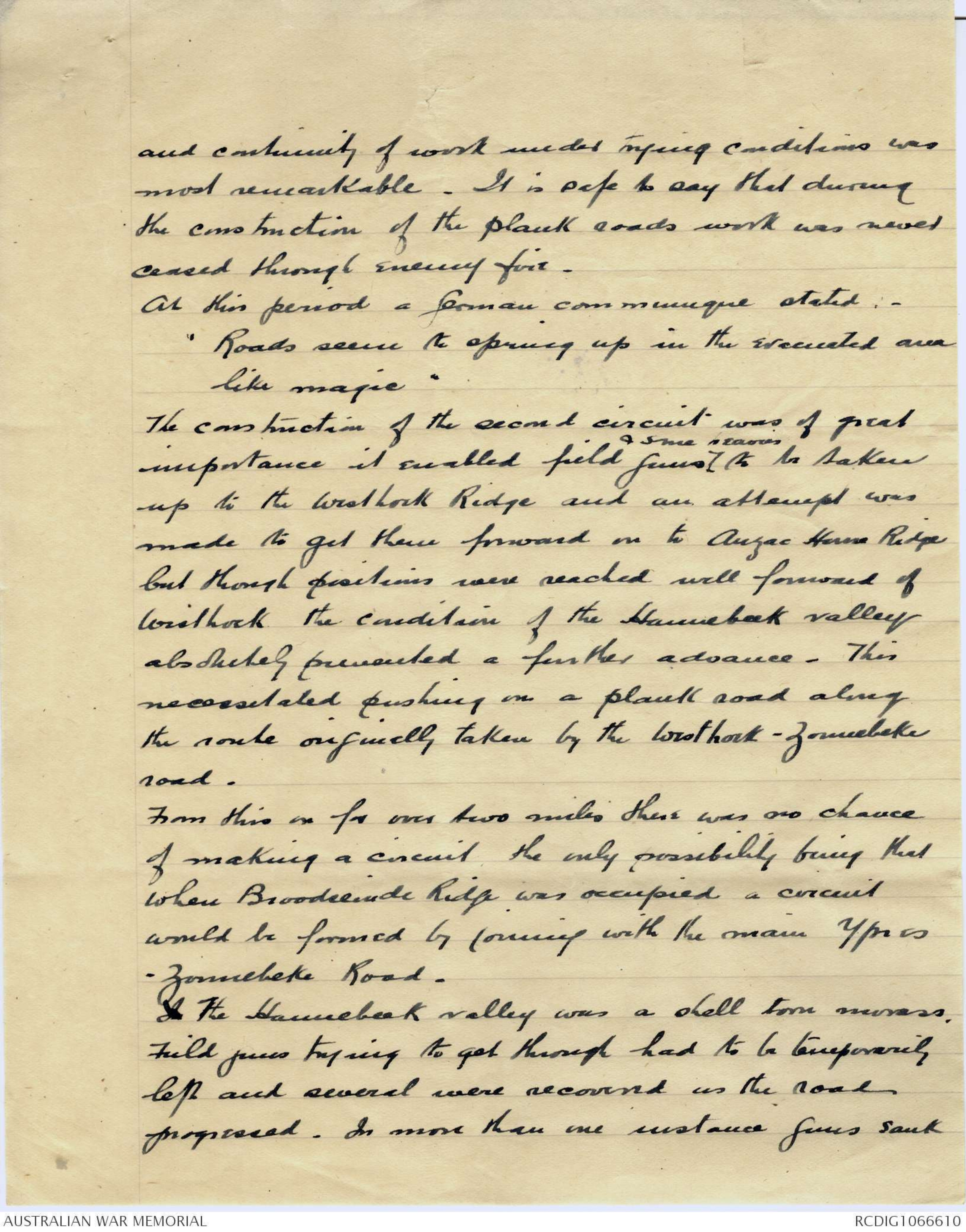
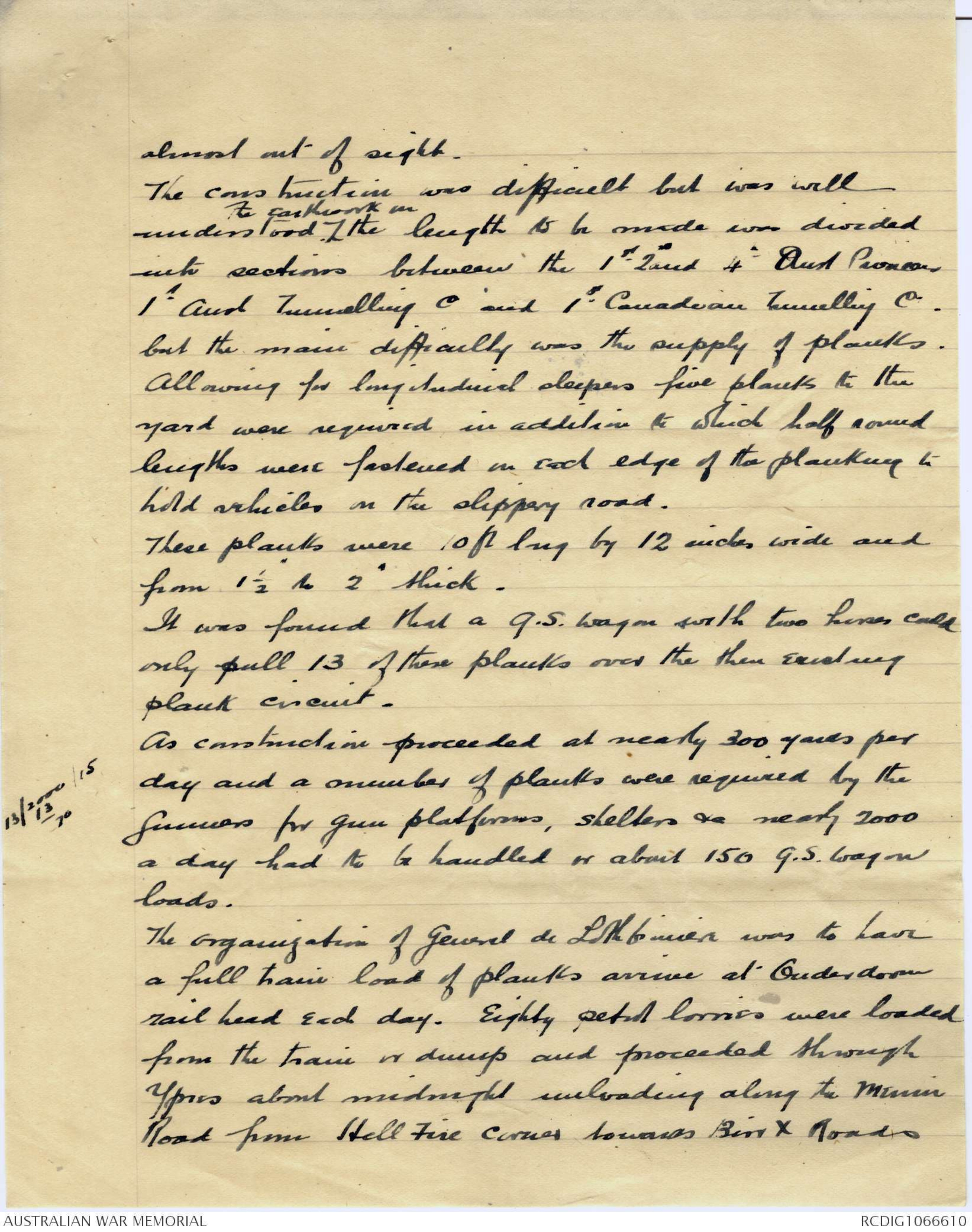
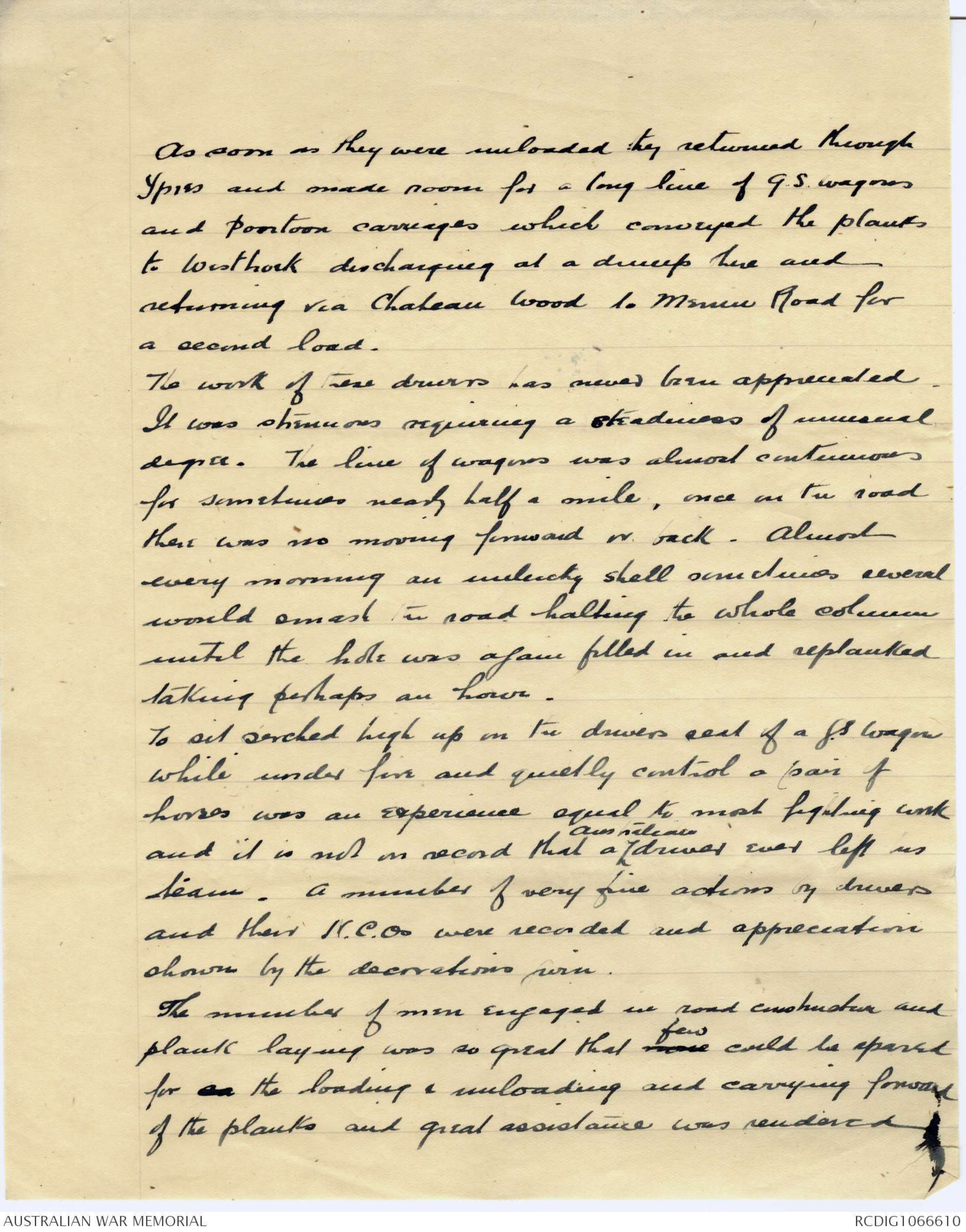
extraordinarily capable units the Army Service Troops
Field Cos of Engineers, not once for a period of
seven weeks was traffic stopped for more than
three hours. Captains Keys, Harris & Owen were
exceptionally capable, the former was the inventor
of the Keys hut afterwards extensively used in the
Australian Corps.
Another British officer who did exceptional work
on this road construction was Capt. W. McClean.
Our own officers all did splendid work but the
one who deserves most mention was Lt. Dentrey
of the 1st Pioneers who was killed on the road. He
On reaching Anzac House it was seen that the
completion of the road to Zonnebeke was feasible
and construction of the main road from Friezenberg
past St. Josephs was undertaken so as to form a
circuit.
This work was really arduous, the pavé was
mostly blown up and at the railway crossing
parties were in plain view from Passchendaele
suffering severely but under Lt Col. Henderson the
1st Pioneers carried through their task and a
complete circuit was made as the Canadians
came in greatly facilitating their work against
Passchendaele.
Prior to this the road had been carried through
Zonnebeke across the Railway to Alma.
Altogether 18300 yards of single planking was
laid in x7days - over 100,000 planks were
transported.
The superiority of the plank road under the
particular circumstances of very wet ground and
liability to disturbance by shell fire over light
railways was conclusively proved as parallel
to the road and with the use of it to transport
rails an attempt to build a light railway
was made but so often was it broken by shell
fire and so difficult to maintain that practically
it was never used or really completed in
spite of strenuous efforts.
The cost in casualties was regrettably high
over 1500 casualties occurred among the Australian
troops and many among the British troops assisting.
Comparisons are unnecessary but the Corps
on the Australian right during the same period
constructed under 1800 yards against the Australian
record of 18300 yards.
By far the quickest piece if work was done
by parties from the 1st Aust Pioneers, and 1st Aust
& 1st Canadian Tunnellers.
Orders for a special plank road way from
^near Birr X Rds round Hooge crater towards Zouave wood to carry
a battery of 9 in guns was given at 9 p.m.
and by midnight the following, day the guns
were in position, approximately 700 yards
having been made in 24 hours.
In addition to the plank roads the Aust. Corps
Troops remade and maintained over ten miles
of metal road East of Ypres, the work being
done by British labor Bns under Army Troops
Companies of Engineers and those who saw
the Menin Road and Zillebeke Road will admit
they did their work well.
HN. Work of Pioneers at Ypres 1917
Notes on Menin Road & other communication
from Ypres to Zonnebeke -
A reconnaissance of the area to be occupied by the Aust. Corps
made early in August revealed the fact that practically
no roadways existed except the Lisle Road and Menin
Roads. The former in fair order towards St Eliz, the latter
almost unusable beyond Hell fire corner.
The cross road from Hell fire corner to Zillebeke was barely
passable and the road from Zillebeke to Birr X Roads
obliterated.
From Birr X roads to Hooge crater the road was impassible
for wheeled travel.
A fair plank road had been constructed from the
neighbourhood of Belgium Battery Corner to the Lisle Road
and from these eastward towards Zillebeke a good
attempt to lay a plank road had been made -
Outside of this nothing existed.
The first work was to reconstruct to Menin Road, the
Lisle Road - Zonnebeke Road and give a lateral communication
from Hell fire corner to Zillebeke and ^construct a converging road
from Zillebeke to Birr X Roads.
The latter being the most urgent as operations waited
on the artillery being in position and a regular supply
of ammunition ensured.
Thirteen days were given for the construction of this
Road and it was completed in eleven days, mainly
by the 5th Pioneer Bn. under difficult conditions, work
being interrupted by frequent shelling and somewhat
irregular transport. A considerable number of casualties
from shell fire and gas impeded the work.
At the same time the British Army Troops Cos under
extremely keen and efficient engineer officers with a
large personnel taken from Labor Battalions made
excellent progress with the metal roads, making
the Menin Road useful to Birr x Roads in which work
the 1st ^Aust Pioneers did splendidly reopening Hellfire
Corner-Zillebeke Road and getting a roadway into
Zillebeke from the Lisle Road.
While this main construction was going forward a
plank road circuit was being done by Aust Engineers
from Birr X Roads to Idiot Corner, thence to Chateau
Wood returning through Chateau Wood past Hooge
Crater.
Maj. General CBB White then found the congestion at
Birr X Roads too great and a further length of
plank road was constructed from a point between
Hell Fire Corner and Birr X Roads to the Idiot corner
plank circuit -
The condition of the country East of Ypres over which
these roadways were made was bad, shell holes
filled with water continuously breaking up the ground.
The roads were required for guns, wheeled transport
and the accumulation of an enormous ammunition
supply, consequently in addition to these several
duck walk tracks for the use of infantry had to
be laid.
The arrangements made by Bn General Jolly de Lotbiniere
were well nigh perfect and the detail carried out
by Capt. Sheldon and Capt Gresulies excellent.
Without this staff work no amount of effort by the
Engineers & Pioneers would have been effective.
The advance on Westhoek Ridge which had waited on
the necessary road construction showed that bad as
the ground over which the Australians had worked from
Ypres it was much worse in advance. The
shell holes were almost touching, original metal
country roads had entirely disappeared while the
destruction of culverts had caused a small brook
to spread making almost a swamp.
A second circuit of plank roads was necessary
from Idiot Corner to Westhoek, thence to J7 returning
to Chateau Wood.
The main position of the section Idiot Corner to Westhoek
was done by the 1st Pioneers, the Westhoek - J7 section
by the 1st Canadian Tunnelling Co and the J7-Chateau Wood
by 5th Div Engineers and Pioneers. H Q
So soft was the ground that in the Idiot-Corner-Westhoek
Section that considerable lengths had to be built
on facines or large bundles of brush wood. Most
of this area was under very good observation by the
Germans but fortunately visibility nearly the whole
time especially the mornings was very low.
The transport of planks was most difficult the roads
being only 10 ft wide did not permit two vehicles to
pass and to leave the road meant practically losing
the wagon in the shell holes. It is estimated that
for every five yards of this road either a wagon
was destroyed or a horse killed, and the number
of casualties among the construction parties was greater
than that of Infantry battalions in xxxxx actions at
the same time proportionately to their numbers.
Over 400 officers and men were killed and eleven
hundred wounded in making the whole of the
communications in one morning three exceptionally
good officers ^of the 1st Pioneer Bge all of whom had served in the ranks at
Gallipoli Capt Harvey, Lt J Wilson, Lt B were killed
Nothing seems to alter the pace of the Australian Pioneers,
the men were admittedly for the first half of the
campaign in France xxxxx selected specially
for their physique and probably the conditions of their
work enabled them to secure better regular food and
certainly they liaised themselves in a superior manner
to most troops but allowing for this their stealthiness
and continuity of work under trying conditions was
most remarkable. It is safe to say that during
the construction of the plank roads work was never
ceased through enemy fire.
At this period a German communique stated:-
"Roads seem to spring up in the evacuated area
like magic"
The construction of the second circuit was of great
importance it enabled field guns ^& some heavies to be taken
up to the Westhoek Ridge and an attempt was
made to get these forward on to Anzac House Ridge
but though positions were reached well forward of
Westhoek the condition of the Hannebeek valley
absolutely prevented a further advance. This
necessitated pushing in a plank road along
the route originally taken by the Westhoek-Zonnebeke
road.
From this as for over two miles there was no chance
of making a circuit. The only possibility being that
where Broodseinde Ridge was occupied a circuit
would be formed by joining with the main Ypres
- Zonnebeke Road.I The Hannebeek valley was a shell torn morass,
Field guns trying to get through had to be temporarily
left and several were recovered as the road
progressed. In more than on instance guns sank
almost out of sight
The construction was difficult but was well
understood. ^The earthwork in the length to be made was divided
into sections between the 1st 2nd and 4th Aust Pioneers
1st Aust Tunnelling Co and 1st Canadian Tunnelling Co.
but the main difficulty was the supply of planks.
Allowing for longitudinal sleepers five planks to the
yard were required in addition to which half round
lengths were fastened in each edge of the planking to
hold vehicles on the slippery road.
These planks were 10ft long by 12 inches wide and
from 1½" to 2" thick.
It was found that a G.S. Wagon with two horses could
only pull 13 of these planks over the then existing
plank circuit.
[*13/2000/15
13/70*]
As construction proceeded at nearly 300 yards per
day and a number of planks were required by the
Gunners for gun platforms, shelters & nearly 2000
a day had to be handled or about 150 G.S. wagon
loads.
The organization of General de Lotbiniere was to have
a full train load of planks arrive at Ouderdom
rail head each day. Eighty petrol lorries were loaded
from the train or dump and proceeded through
Ypres about midnight unloading along the Menin
Road from Hell Fire Corner towards Birrs X Roads
As soon as they were unloaded they returned through
Ypres and made room for a long line of G.S. wagons
and Pontoon carriages which conveyed the planks
to Westhoek discharging at a dump there and
returning via Chateau Wood to Menin Road for
a second load.
The work of these drivers has never been appreciated.
It was strenuous requiring a steadiness of unusual
degree. The line of wagons was almost continuous
for sometimes nearly half a mile, once on the road
there was no moving forward or back. Almost
every morning an unlucky shell sometimes several
would smash the road halting the whole column
until the hole was again filled in and replanked
taking perhaps an hour -
To sit perched high up in the drivers seat of a G.S Wagon
while under fire and quietly control a pair of
horses was an experience equal to most fighting work
and it is not on record that a ^Australian driver ever left his
team. A number of very fine actions by drivers
and their N.C.Os were recorded and appreciation
shown by the decorations given.
The number of men engaged in road construction and
plank laying was so great that more few could be spared
for xx the loading & unloading and carrying forward
of the planks and great assistance was rendered
 Sandy Mudie
Sandy MudieThis transcription item is now locked to you for editing. To release the lock either Save your changes or Cancel.
This lock will be automatically released after 60 minutes of inactivity.